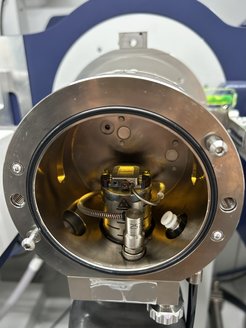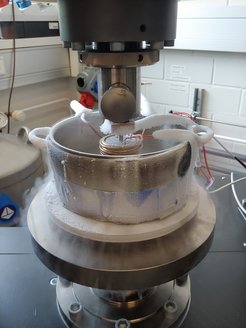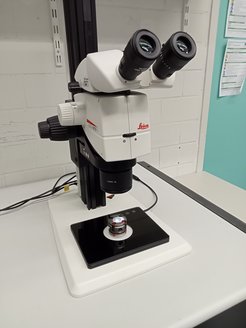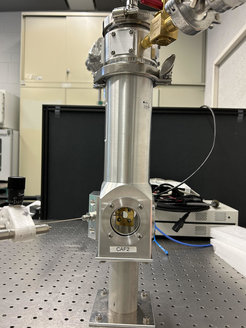Methods
X-ray diffraction
Powder diffraction
We use a Rigaku SmartLab X-ray diffractometer in order to perform powder diffraction and X-ray reflectivity measurements. The diffractometer can be combined with an Anton Paar low temperature chamber (TTK) to characterize e.g. different ice phases.


Small-angle-X-ray diffraction
A home-build instrument for small angle X-ray scattering (SAXS) and a 6-circle diffractometer for experiments on surfaces and thin films are available for the measurements. Temperature dependent measurements allow to study phase transitions and relaxation processes into thermodynamic equilibrium.


Sample preparation
Piston-cylinder setup
Using a piston cylinder setup with the ZwickRoell Z100/TL testing machine allows for conducting high-pressure ice experiments. With a maximum applicable force of 100 kN, it is possible to investigate samples at pressures up to 2 GPa. Varying the temperature from approximately 77 K to room temperature can be achieved with a temperature controller (Eurotherm 3508). The combined measurement of applied pressure, temperature and piston displacement makes it possible to characterize phase transitions of ice samples.


Diamond anvil cell
In our laboratory, we use a symmetric diamond anvil cell (DAC). Between the two diamonds, pressures of more than 300 GPa can be achieved. With the diamonds being several hundreds of nanometers in size, the Leica M125 C microscope helps positioning the sample. Additionally, we have a self-built ruby setup combined with an Ocean Optics HR4000 spectrometer in order to determine the pressure inside the DAC.

Vapor deposition
To prepare amorphous solid water (ASW), water vapor is deposited onto a cold substrate. The vapor deposition occurs in vacuum, while the substrate, here a CaF2 window, is cooled using a liquid nitrogen cryostat (Janis VPF-100). The setup allows for in-situ infrared spectroscopic studies and X-ray scattering to determine the structure of the so-prepared ASW.

Optical microscope
We use an Infinity K2 DistaMax long distance microscope, combined with a camera and a computer to read out the images.









